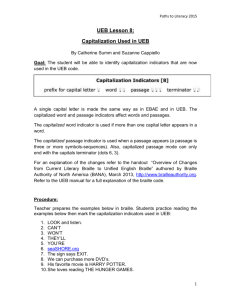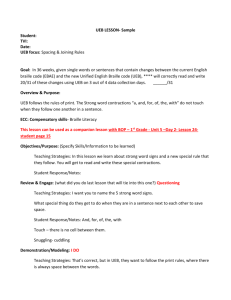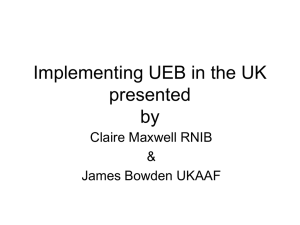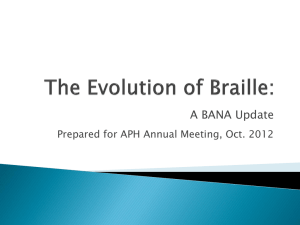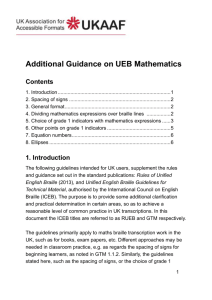502b
advertisement
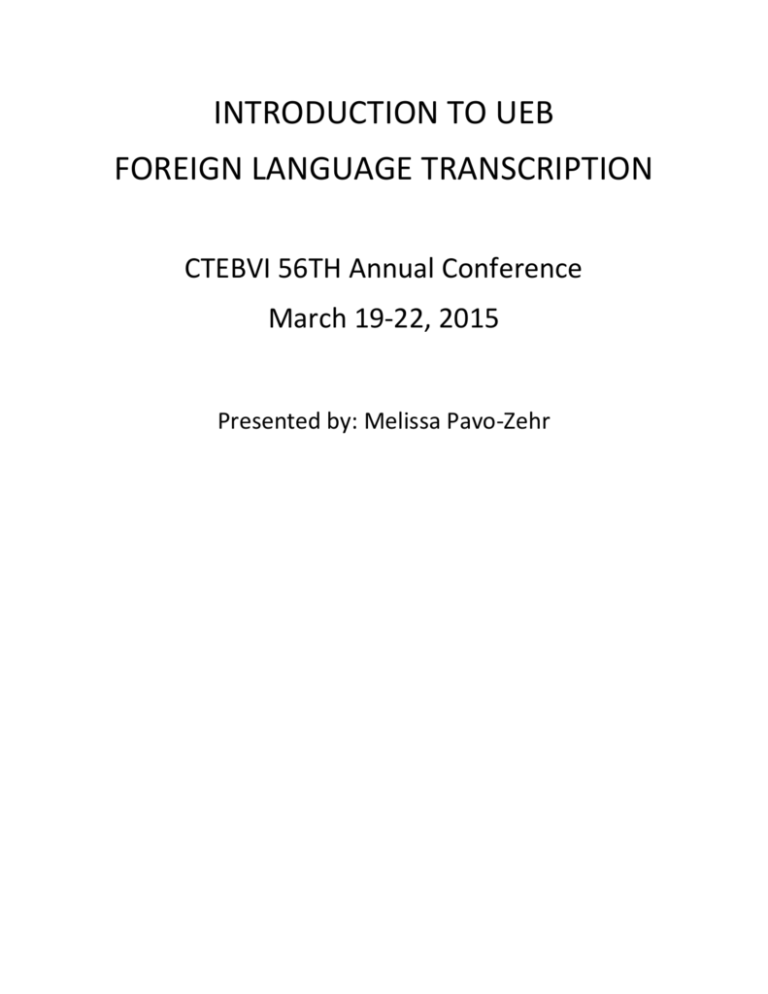
INTRODUCTION TO UEB
FOREIGN LANGUAGE TRANSCRIPTION
CTEBVI 56TH Annual Conference
March 19-22, 2015
Presented by: Melissa Pavo-Zehr
Determining what is Foreign:
• BF 1.15.2 Foreign Material. For the purposes of
agencies and transcribers working with codes of the
Braille Authority of North America, any language other
than modern English is considered a foreign language.
This includes Old English, and Middle English, as well as
transliterated or Romanized forms of languages such
as Arabic, Chinese, Greek, Hebrew, Japanese, and
Russian.
• FL 2002 1.1a Foreign language. For the purposes of
agencies and braillists working with official braille
codes provided by the Braille Authority of North
America (BANA), any language other than modern
English must be considered foreign.
• UEB 13.1.1 A foreign language is any natural or
artificial language in use now or in the past other than
English. It may be written in Roman or non-Roman
script. Any form of English transliterated in non-Roman
script is also to be treated as foreign.
There are three categories with their relative subcategories of usage when dealing with foreign words in
UEB:
1) Foreign words in English context where language is
not expected to be known
a) Modifiers
2) Foreign words in English context where language is
expected to be known (or currently learning)
a) Foreign code signs
b) Code Switch Indicators
3) Entirely foreign text
a) Contractions
b) Punctuation
c) French code– Antoine numbering system or
Louis Braille Numbers
UEB 13.5.1 Use UEB signs to represent accented letters,
punctuation or Greek letters where it is judged likely that
most readers will be unfamiliar with the foreign code
signs, and where the nature of the material does not
create a reasonable expectation that they should learn
them. UEB signs should therefore be used:
• For occasional foreign words and phrases occurring
in English context;
• For longer foreign passages such as conversation
occurring in English novels or in other English works
regarded as primarily for leisure reading.
Refer to: Section 4, Letters and their modifiers, for the
complete list of UEB signs for accents and Greek letters.
Again, similarities are:
• UEB 4.2.1 Place a modifier before the letter it modifies
in braille, irrespective of whether it appears above,
below or overlaying the letter(s) in print.
• BF 1.15.3 A contraction is not used when an accented
letter is part of a contraction.
• UEB 4.2.4 A modified letter may not form part of a
contraction.
Examples:
blessèd B.S^*ED
Löwenthal ,L^3OW5?AL
• Contracted with modified letter BF2011 1.15.3
Foreign language words or phrases within an English
language paragraph are contracted as though they
are English. Use the dot 4 accent indicator
(Appropriate MODIFIER) for accented letters.
The word “demonstrate”
demonstrare.
comes
from
the
Latin
,! ^W 8DEMON/RATE0 COMES F !
,LAT9 ^1DEMONSTRARE4
• Bold UEB 9.1.2 Typeform indicators are considered
necessary in braille when the print change in typeform is
significant because it indicates emphasis or shows
distinction, e.g. foreign words in English text, …
• UEB 13.1.2 … Attention should be paid to
typography, since italics or (less frequently) bold
or quotation marks are often used to distinguish
words regarded as foreign from those regarded as
anglicised.
• UEB 13.2.1 Except as provided for in the note below, do
not use contractions in words, phrases or passages which
are regarded as foreign, including any English words within
the expression.
• Note: It is permissible to disregard this rule
provided that there are appropriate braille
authority policies and guidelines in place which
transcribers in your country are expected to
follow to ensure that ambiguity is avoided.
[BANA to implement/continue BF2011 1.15.3
(demonstrare would then be contracted)]
,! ^W 8DEMON/RATE0 COMES F !
,LAT9 ^1DEMON/R>E4
The foih-chai, the trains, tugged freight cars that banged
together like thunder.
,! .1FOIH-*AI1 ! TRA9S1 TU7$ FREI<T
C>S T BANG$ TGR L ?"U4
Therese is very chic. ,!RESE IS V .1*IC4
3. Ménard, Marc. Élements pour une économie des
industries culturelles. Montreal: SODEC, 2004.
#C4 ,M^/EN>D1 ,M>C4 .7,^/ELE;TS P\R
UNE ^/ECONOMIE DES 9DU/RIES
CULTURELLES4.' ,MONTR1L3 ,,SODEC1
#BJJD4
—¡Qué idea más buena!—exclaimed Pedro's mother.
,-.7^;6,QU^/E IDEA M^/AS
BU5A6.',-EXCLAIM$ ,P$RO'S
"M4
• Conversational open dash (6, 36)
• Italic passage indicator (46, 2356)
• UEB 13.5 Using UEB signs: opening inverted exclamation
mark
• Modifier 4.2: acute accents for both letters e and a (45, 34)
• Note closing exclamation mark is the same
• Italic terminator (46, 3)
• Dash Instruction Manual for Braille Transcribing –
UEB Edition, 2015 2.6 [UEB 7.2]
… remember that hyphens join words and word parts
together and dashes separate thoughts or ideas.
• UEB 7.2.1 Follow print for spacing of the dash.
Category 2 requires the student to have a sufficient
knowledge of or be learning the language, which then
requires foreign code signs.
BF 1.15.4 Foreign Language Guidelines for Braille
Transcription apply when a complete section, story,
poem, etc. is in a foreign language. (Including
instructional texts as defined by 1.15.1). This portion
of text is uncontracted, and the appropriate foreign
accented letters and punctuation marks are used.
UEB 13.6.1 Use foreign code signs in the
representation of foreign language material where
there is substantial occurrence of the foreign
language, as in:
grammars and other instructional materials,
English commentaries on foreign works for
study,
bilingual texts (whether set out in parallel or
consecutively) such as official forms, opera
libretti and other translations, and
any situation where significant knowledge of the
foreign language is presupposed or being
taught.
Refer to: the most recent edition of World Braille Usage
which lists by country signs used in categories (1) [foreign
code signs] (3) [foreign punctuation indicative to the
country].
FL 2002 1.3b
• b. Predominantly foreign text with some English.
(Paraphrase: Contract sections occurring in English,
manage the rest as stated in part a.)
• FL 2002 1.3c (1) With a Single Foreign Language.
Transcribe the English material in such texts in
contracted English braille. Foreign material in such
texts is transcribed in uncontracted braille, using the
appropriate foreign alphabet symbols. (foreign code
signs)
DO NOT:
Use a UEB sign that conflicts with an element in the
foreign code 13.6.4
Mix foreign code signs and the equivalent UEB signs
for the same language in the same book. 13.6.4
Examples:
[from a workbook for children learning French:]
Answer the following questions using «il y a ... (que), ça faît ...
(que), depuis» (sometimes there are several possibilities).
Il y a combien de temps que tu vas dans ce collège? (deux ans)
,ANSW] ! FOLL[+ "QS US+ .7_8IL Y A 444
"<QUE">1 &A FA%T 444 "<QUE">1 DEPUIS_0.'
"<"S"TS "! >E S"EAL POSSIBILITIES">4
,IL Y A COMBIEN DE TEMPS QUE TU VAS DANS CE
COLL!GE8 "<DEUX ANS">
• Contracted braille for English
• Opening italic passage indicator (46, 2356)
• Opening and closing Italian quote, Ellipsis, open and close
parenthesis UEB 7: Punctuation
• All French code signs are appropriated for UEB, FL 2002,
BF 2011
[from a bilingual, English and French, government document:]
Make the certified cheque or money order (for Licence Renewal
Fee only) payable to the Minister of Finance.
Libellez le chèque certifié ou le mandat (concernant le droit de
renouvellement du permis seulement) à l'ordre du minister des
Finances.
,MAKE ! C]TIFI$ *EQUE OR M"OY ORD]
"<.7= ,LIC;E ,R5EWAL ,FEE ONLY.'">
PAYABLE TO ! ,M9I/] ( ,F9.E4
.LIBELLEZ LE CH!QUE CERTIFI= OU LE
MANDAT 73_CONCERNANT LE DROIT DE
RENOUVELLEMENT DU PERMIS _SEULEMENT7
( L'ORDRE DU MINISTRE DES .FINANCES4
• Sentence in English done according to UEB
(contracted, italics open and close in order
• French capital indicator (46) World Braille Usage,
Third Edition 2013, pg. 181; UEB Section 13;
CBFU 2008
• French code signs utilized throughout UEB 13.6,
13.6.2, 13.6.4; FL 2002 1.3b; BF2011 1.15; CBFU
2008
• Open and close parentheses– Here; it’s (2356).
According to WBU 2013 page 181 its (236) open and
(356) close; and according to the CBFU 2008, as
shown below:
• French opening italic passage indicator (25, 456)–
UEB 13, CBFU 2008 pg. 23
• French closing italic passage indictor (456)– UEB 13;
CBFU 2008 pg. 45
[from Con brío! Activities Manual Second Edition 2010)
2-15 ¿Cuál es el resultado?
Roberto is trying to explain how he and some of his
friends are feeling given their particular
circumstances. Read the clues and help him complete
the description.
Modelo
Tú no tienes (have) tarea esta noche.
Estás contento.
#B-#AE 5,CU(L ES EL RESULTADO5
,ROB]TO IS TRY+ TO EXPLA9 H[ HE &
"S ( 8 FRS >E FEEL+ GIV5 _! "PICUL>
CIRCUM/.ES4 ,R1D ! CLUES & HELP HM
comPLETE ! DESRICRIP;N4
^1,MODELO
,T) NO TIENES 7.1H7 TAREA ESTA
NOCHE4
.1,EST(S .1CONTENTO4
• Number indicator repeated after hyphen UEB 6.3.1
• Directions given in English and contracted as such– FL
2002 1.3.3a; BF2011 1.15.4
• Blank line before and after Modelo– BF2011 10.8.3; FL
2002 9.3b
• Retain bold on Modelo– BF2011 10.8.1
• Sentences following in same format as exercises.– BF2011
10.8.4; FL 2002 9.3b(2)
• Have retains italics and is contracted– UEB 2.3.1 Follow
print when transcribing into braille, including accents,
punctuation, and capitalization. FL2002 1.3c(1)
NOTE: Normally we would not use italics due to the
enclosures being sufficient
• Follow print in last example sentence, using the italic word
indicator (46, 3) Typeform
• Spanish code signs utilized– WBU 2013 pg. 201
UEB 13.7 Code Switch Indicators (useful in many texts,
especially instructional)
UEB 13.7.1 Code switch indicators are used to enclose
non-UEB material, in this case material using foreign code
signs. Do not use UEB signs within code switch indicators.
UEB 13.7.2 When the nature and extent of the
enclosed material can be clearly deduced from
formatting or other contextual considerations, as
when parallel texts in English and another language
are set out in tabular form or when the foreign
language is identified by a change of typeface, then
code switch indicators may be omitted.
UEB 14.2.1 When a text is to be read in hardcopy
braille, do not use code switching indicators when the
nature and extent of the non-UEB text can be
determined by the context or format.
[from a textbook teaching Greek:]
The unemphatic forms, μου, μοι, με, are enclitic.
,! UNEMPHATIC =MS1 "('MU1 M[1 ME1,")
>E 5CLITIC4
• Code switch indicators used to enclose the Greek– UEB
13.7.1; 14.2.4 (Use code switching indicators when the
non-UEB braille would be ambiguous and when the nature
and extent of the non-UEB text cannot be determined by
the context or format.
• UEB 14.3.2 Use non-UEB passage indicators when there
are three or more symbols-sequences in the non-UEB
braille code. The effect of a non-UEB passage indicator
continues until the closing non-UEB passage indicator.
Open (5, 12356, 3) Close (6, 5, 23456)
[ from ¡Con brío! Activities Manual Second Edition 2010]
2-8 ¿Dónde están?
Susana missed every question on a recent quiz because she
confused the verb ser with estar. Now, Professor González has
asked her to correct her mistakes by doing the quiz over again.
Help out Susana by writing in the appropriate forms of the verb
estar.
#B-#H 5,D+NDE EST(N5
,SUSANA MISS$ E "Q ON A REC5T QUIZ 2C %E
3FUS$ ! V]B ^1SER ) ^1ESTAR4 ,N[1 ,PR(ESSOR
^(,GONZ(LEZ HAS ASK$ H] TO CORRECT H]
MI/AKES BY DO+ ! QUIZ OV] AG4 ,HELP \
,SUSANA BY WRIT+ 9 ! APPROPRIATE =MS ( !
V]B ^1ESTAR4
• Repeat Number indicator after hyphen– UEB 6.3.1
• Use appropriate Spanish code signs UEB 13.6; BF2011
1.15.4; FL 2002 1.3c(1)
• Contractions used within directions except for Spanish
verbs and González– UEB 13.6.3, 13.6.4 … Also do not
mix foreign code signs and the equivalent UEB signs for
the same language in the same book.
• Verbs uncontracted according to UEB 13.2.1; BF2011
1.15.4; FL 2002 1.3
• González utilizes a word code switch indicator UEB 14.3.1
Place the non-UEB word indicator immediately preceding
the symbols-sequence to which it applies. Its effect is
terminated by the next space or by the next non-UEB word
terminator.
• Retain bold throughout– UEB 13.1.2; 2.3.1; FL 2002 3.3.1b;
BF2011 5.1.7a
UEB 13.7.3 If the main body of text is in a foreign language
with occasional words or passages of English interspersed,
e.g. by way of commentary or explanation, it is recommended
that the function of the code switch indicators should be
reversed, so that they enclose the UEB material. Explain this
reversal in a transcriber’s note.
[French :]
Souvent précédé d'une conjonction de subordination telle que
"quand", "dès que" (immediately), "aussitôt que".
.SOUVENT PR=C=D= D'UNE CONJONCTION DE
SUBORDINATION TELLE QUE 8QUAND01 8D!S QUE0
^("<IMMLY">1 8AUSSIT?T QUE04
• French code signs and capital indicator– UEB Section 13;
CBFU 2008; WBU 2013
• English utilizes code switch indicators– UEB 13.7.3 above
RECAP: Until now we have been reviewing how to use:
1) Modifiers in place of the non-existent dot 4;
UEB 13.4.1 There are two ways to represent accented
letters in braille within a UEB context:
• by means of UEB signs for modifiers (13.5), …
• Hybridisation of these two methods is to be avoided since
UEB symbols and foreign code signs are different and may
conflict
• 13.2.1 … do not use contractions in words, phrases or
passages which are regarded as foreign … and 4.2.4 A
modified letter may not form part of a contraction.
• 13.5.3 When UEB signs are used, do not use code switch
indicators.
• 13.5.1 Use UEB signs to represent accented letters,
punctuation or Greek letters where it is likely that most
readers will be unfamiliar with the foreign code signs, and
where the nature of the material does not create a
reasonable expectation that they should learn them.
2) Using Foreign Code Signs 13.6
UEB 13.4.1 Represented accented letters by means of
foreign code signs (13.6).
• 13.6.1 Use foreign code signs in the representation of
foreign language material where there is substantial
occurrence of the foreign language …
• 13.6.4 Do not use a UEB sign that conflicts with an
element in the foreign code. Also do not mix foreign code
signs and the equivalent UEB signs for the same language
in the same book.
• 13.7.2 When the nature and extent of the enclosed
material can be clearly deduced from formatting or other
contextual considerations, as when parallel texts in English
and another language are set out in tubular form or when
the foreign language is identified by a change of typeface,
then code switch indicators may be omitted.
• 13.7.1 Code switch indicators are used to enclose non-UEB
material, in this case material using foreign code signs. Do
not use UEB signs within code switch indicators.
• 14.2.5 When code switching indicators with identifiers are
used, explain them either on a special symbols page or in a
transcriber’s note positioned before the affected material.
[See 14.3.3]
Category 3 involves using foreign code signs,
punctuation, and possibly contractions for an entirely
foreign text. This applies, as interpreted and rendered by
World Braille Usage Third Edition 2013; Using the Braille
Spanish Code, Produced by RNIB on behalf of VIEW
Modern Foreign Languages Curriculum Group; UKAAF
Transcribing Foreign Language Material in UEB, Rules of
Unified English Braille 2013.
UEB 13.6.2 In a foreign language braille code, it is
possible to have six categories of sign:
1. Signs representing the basic elements of the
script (whether alphabet, syllabary, or other);
2. Signs representing accents (including indicators
of breathing, tone, stress or quantity);
3. Punctuation signs and indicators;
6. Contractions.
Refer to: The most recent edition of World Braille
Usage which lists by country signs used in categories
(1) to (3).
13.6.3 When foreign code signs are used, do not use UEB
contractions.
13.6.4 When using foreign code signs for basic elements
of script and/or for accents, that is, categories (1) and (2)
above, it is permissible though not required to use the
foreign code signs for any of the other categories. (Hence
the references to the publications and the “Methods” with
examples including UEB; i.e., the French capital
indicator.)
13.6.5 List all foreign code signs used on a preliminary
page.
13.6.6 Use foreign code contractions, i.e. category (6)
above, only for a language written in Roman script which
is also one of the official languages of the country from
which the document originates or for which it is
requested. However, in no case is the use of foreign code
contractions mandatory.
FL 1.3a. Entirely Foreign Text. Transcribe such texts
using uncontracted braille and the appropriate foreign
alphabet symbols (foreign code signs) as provided in
Sections 13 and 14. (World Braille Usage, Third Edition,
2013)
Using the World Braille Usage, Third Edition, 2013
Spanish Signs, Punctuation, and Contractions
There are only two contractions:
.=> Æ: diphthong (where the “a” and “e” are written out
separately in print, you should do the same.)
.== LL: only in words where it is pronounced as “y”. If it
is pronounced as “l”, the “ll” should remain uncontracted.
World Braille Usage 2013 pgs. 201-202 has Spanish letters and
punctuation.
SPECIAL SYMBOLS USED IN THIS VOLUME
.=(
.=!
.=/
.=]
.=+
.=)
.=\
,SPANI% code signs
;A-ACUTE
;E-ACUTE
;I-ACUTE
;N-TILDE
;O-ACUTE
;U-ACUTE
;U-DIAERESIS
,SPANI% PUNCTUA;N Signs
.=' ,P]IOD
.=9 ,ITALICS OP5 & CLOSE
.=6 ,2G9N+ & 5D+ EXCLAMA;N PO9T
.=5 ,2G9N+ & 5D+ "Q M>K
.=,1 ,SLA%
.=. ,CAPITAL 9DICATOR
.=9 ,A/]ISK
.=8 ,OP5 & ,CLOSE QUOTA;N M>KS
…
• Dash and hyphen are the same. World Braille Usage 2013
pg. 201
• UEB 3.13.1 When a dot locator for “mention” is used, do
not list the dot numbers of the braille symbol.
Examples:
(from El Nuevo Houdini past tense version Capítulo 2)
Capítulo 2
¡Adiós!
A las cinco de la mañana, los padres de Brandon entraron al
dormitorio de Brandon para decirle "Adiós". Su madre le dijo:
--Brandon...
Brandon dormía y no le respondió.
--Brandon...nos vamos.
1
Brandon no le respondió y su madre tocó la cama Brandon
continuó
1
cama: bed
durmiendo. Entonces, su
.CAP/TULO #B
6.ADI+S6
.A LAS CINCO DE LA MA]ANA1 LOS PADRES DE
.BRANDON ENTRARON AL DORMITORIO DE .BRANDON
PARA DECIRLE 8.ADI+S8' .SU MADRE LE DIJO3
--.BRANDON'''
.BRANDON DORM/A Y NO LE RESPONDI+'
--.BRANDON'''NOS VAMOS'
.BRANDON NO LE RESPONDI+ Y SU MARE TOC+
LA CAMA';9#A .BRANDON
;9#A CAMA3 B$
CONTINU+ DURMIENDO' .ENTONCES1 SU
Capital indicator: dots (46)
Quotations open and close: (236, 236)
Full Stop, Period: (3)
Comma, colon, ellipsis, exclamation and question marks,
conversation marks (dashes and hyphens): same
Centered Heading: BF2011 4.3.3
Gloss Note: FL 2002 4.4
Note Indicator: UEB 3.24.1
Me llamo Melissa.
.ME =AMO 9.MELISSA9'
Capital indicator: (46)
Double ll with y sound contraction (123456)
Begin italic (35) placed before capital indicator (46),
close italic (35), full stop (3)
French Signs
World Braille Usage 2013 pages 180-181.
.=*
.=(
.=&
.==
.=<
.=$
.=!
.=%
.=]
.=?
.=[
.=:
.=\
.=)
.=1
.=2
.=3
.=4
.=5
…
,FR5* Code SignS
;A-,CIRCUMFLEX
;A-,GRAVE
;C-,CEDILLA
;E-,ACUTE
;E-,CIRCUMFLEX
;E-,DIAERESIS
;E-,GRAVE
;I-,CIRCUMFLEX
;I-,DIAERESIS
;O-,CIRCUMFLEX
;O-;E ,LIGATURE
;U-,CIRCUMFLEX
;U-,DIAERESIS
;U-,GRAVE
,PUNCTUA;N
,COMMA
,SEMICOLON
,COLON
,P]IOD1 FULL /OP
,"Q M>K
Examples:
(the next 5 are from Première partie Le code braille de base
2008)
À cette époque --juin 2001-- fut signé un Accord de
coopération à Casablanca.
.( CETTE =POQUE --JUIN ,<##*-- FUT
SIGN= UN .ACCORD DE
COOP=RATION (
.CASABLANCA4
• Capital indicators used throughout– (46)
• Dash, guide dash– (36) WBU 2013 page. 181
• Antoine numbering using mathematical modifier
(Tid bit : Notation Antoine: writing numbers and arithmetic
signs of borrowed base; the mathematical braille notationdocument originally published in France in 1971 and revised in
2007.
Louis Braille notation: writing the digits following the
representation defined in originally by Louis Braille.
Tirets, dashes or hyphens are spaced as in print.
le chien _LE _CHIEN
la Vingt-cinquième heure
_LA _.VINGT-CINQUI!ME _HEURE
les travailleurs de la mer
3_LES TRAVAILLEURS DE LA _MER
General emphasis indicator: (456)
General emphasis indicator placed before capital indicator;
each word indicted as its 3 words or less
Begin French passage indicator (25, 456), ending french
passage indicator (456) [UEB Section 13, Code braille
français uniformisé pour la transcription des textes
imprimés 2.2c) NOTE: the end passage indicator is placed
before the last word in the passage; contrary to UEB
ordering
« Si j'étais roi [...] qu'est-ce je ferais, qu'est-ce que je penserais,
comment est-ce que j'agirais? » [Guy de Maupassant, Pierre et
Jean et autres récits]
7.SI _J,''=TAIS ROI ^84440B QU'EST-CE _JE
FERAIS1 QU'EST-CE QUE _JE PENSERAIS1
COMMENT EST-CE QUE _J,''AGIRAIS57
Open and close quote, guillemet (2356)
General Emphasis indicator applied to single letter and
terminated by termination indicator (456), (6, 3)
Open brackets (45, 236); point (256); close bracket (356,
12)
General Emphasis indicator– applies to words as well (456)
German Signs, Punctuation, and Contractions
World Braille Usage 2013 pages 182-183.
.=>
.=[
.=\
.=!
,G]MAN CODE SIGNS
;A-UMLAUT
;O UMLAUT
;U UMLAUT
ESS-TSETT
.=*
.=<
.=%
.=?
.=:
.=)
.=/
.=+
,VOLLS*RIFT ,3TRAC;NS
AU
EU
EI
CH
SCH
ST
>U
IE
,PUNCTUA;N
.=' ,FULL /OP
.=5 ,"Q M>K
.=6 ,EXCLAMA;N M>K
.=, ,APO/ROPHE
.=,- ,DA%
.="1 ,SLA%
.=. ,CAPITAL
.=_ ,ITALICS
'''
Note: from Das System der deutschen Blindenschrift 2005
Section 2.6
In German, capitalization is basically dispensed with. With these
exceptions:
In legal writing
In dictionaries
Unique abbreviations
Symbols for dimensions, weights, and other engineering
units Units of currency
Examples:
Bäume B/ME
Baum B*M
Statistik )ATI)IK
• Die Vollschirft (contractions)
Sie hat sich immer bemüht, doch gegen Dummheit
kämpfen selbst Göttinnen vergebens:
SIE HAT SICH _IMMER BEM\HT1 DOCH __GEGEN
DUMMHEIT K>MPFEN SELBST G[TTINNEN
VERGEBENS,''
Italics indicator (456); WBU 2013 top of page 183
Italics indicator for passage [three or more words] (456,
456); end passage (6, 3); full stop (3); Das System der
deutschen Blindenschrift 2005 Section 2.7 pgs. 34-35
Es ist nur ein Gedankenspiel:
ES IST NUR EIN GEDANKEN,_SPIEL'
Beginning italics inside a word (6, 456); German Braille
Code 2.7
Ending attribution– space or full stop (3); WBU 2013 pg.
182
No contractions may form part of the italicised word;
BF2011 5.8.1b
WordStar .WORD.STAR
McDouglas .MC.DOUGLAS
• Capital indicator utilized (46); German Braille Code 2.6;
WBU 2013 top of pg. 183
DER FRIEDENSVERTRAG VON VERSAILLES:
^^DER FRIEDENSVERTRAG VON VERSAILLES,''
When there are two situations, use begin (45, 45) and
terminate with (6, 3); full stop (3) [2.7 of German Braille
Code]
Resources
1. The Rules of Unified English Braille Second Edition 2013
2. World Braille Usage Third Edition 2013
3. NBA Interim Manual for Foreign Language Braille
Transcribing 2002
4. Braille Formats Principles of Print-to-Braille Transcription,
2011
5. Das System der deutschen Blindenschrift 2005
6. Première partie Le code braille de base 2008
7. Guías de la Comisión Braille Española Signografía básica
Primera edición, Madrid 2005
8. Comisión Braille Española, Documento Técnico B 2 De La
Comisión Braille Española, Signografía Básica, January
2014
